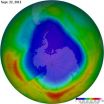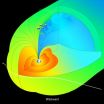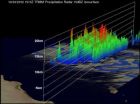(Press-News.org) DeKALB, Ill. -- With Election Day less than a month away, television is filled with talking heads spreading the conventional wisdom of what a Republican or Democratic president might mean for the economy.
However, a group of researchers says, when it comes to the relationship between presidential politics and the behavior of the financial markets, conventional wisdom may not be so wise.
The researchers reviewed more than 40 years of data (1965-2008) in studying the relationship between security returns and four variables: the political affiliation of the president; the presence or absence of political gridlock; the presidential term cycle effect; and Federal Reserve monetary policy. While many academic papers have analyzed those factors separately, the authors of this study considered them simultaneously.
When all four of those factors were taken into account, the researchers concluded, many of the commonly held beliefs about how politics impact the market simply did not hold true.
Markets unmoved by a president's party affiliation
One of the most commonly repeated truisms called into question by the study is that the political affiliation of the president has an impact on the market. In reality, whether the president is a Republican or a Democrat is most often insignificant to the performance of the markets.
"While the party of the president garners much of the attention of the press, it appears that other factors have a much more prominent relationship with security returns," said Gerald Jensen, the Jones, Diedrich, Mennie professor of finance at the Northern Illinois University College of Business. He has spent years studying the topics covered in the study.
The misconception about the president's party affiliation appears to have grown out of research that looked at factors in isolation. For instance, numerous studies have shown that stock returns (especially for small stocks) are substantially higher during Democratic presidencies relative to Republican administrations. Similarly, bond returns during Republican administrations are twice as high relative to returns generated during Democratic administrations.
However, Jensen and his colleagues found that when you control for the other factors considered in this study, the difference in the performance of the markets across presidents from different parties is statistically insignificant.
Gridlock is not good
Many pundits, and researchers, maintain that political gridlock – which occurs when different parties control the White House and the legislature – is good for the market. Under such conditions, they reason, there is less chance of significant fiscal policy actions, which tend to disrupt financial markets.
In reality, the authors report that political harmony is better for equities, especially smaller stock indexes where annualized returns were reportedly 22.38 percent higher during harmony as opposed to gridlock. Even when researchers adjusted for other factors, the benefits of political harmony remained clear, Jensen said.
Despite what the numbers say, the perception that gridlock is good has established itself.
"It has been repeated so often I think that it has sort of been accepted as fact," said Jensen, who speculates that people hang their argument on specific examples, like the Clinton presidency, when markets excelled despite political gridlock, and fail to consider other evidence.
While it is clear that, during the period studied, political harmony coincided with strong equity performance, Jensen and his fellow researchers stop short of saying that there is a dependency between the two. "We have identified a relationship, but we aren't saying that one causes the other," he cautioned.
Time will tell
While elections naturally bring up discussions of how politics influence the markets, Jensen and his colleagues found that political outcomes have little immediate impact. In fact, history has demonstrated that the most favorable return patterns are not manifested in the market for three years.
One theory is that the Federal Reserve loosens monetary policy in ways that reflect favorably upon incumbents in Congress and the White House to help encourage reelection. However, Jensen points out, even when the researchers adjusted for Fed policy changes, the economy seemed to consistently rally in the third year of a presidency.
It's all about the Fed
While much attention is focused on issues such as the president's political affiliation and gridlock, investors might be better served by paying less attention to those factors and more to how the election might affect Federal Reserve policy, Jensen said.
"A tightening of Fed monetary policy generally precedes poor equity market performance and increased inflationary pressures. Ultimately, that factor seems to carry the greatest weight, and that is what investors should pay the most attention to," he said.
"In the end, policies are more important than politics," he continued. "While the Chairman of the Federal Reserve is appointed by the president, I don't think people pay much attention to what party he comes from. They pay attention to what he is doing. Perhaps they should look at politicians the same way. It's not their party affiliations that are important, but the policies that they put forth."
###
The study, "What to Expect When You're Electing, " was conducted by co-authors Scott B. Beyer, associate professor at the University of Wisconsin Oshkosh College of Business; Luis Garcia-Feijoo, assistant professor at Florida Atlantic University College of Business; Robert R. Johnson, professor of finance at Creighton University College of Business and Gerald R. Jensen, the Jones, Diedrich, Mennie professor of finance at the Northern Illinois University College of Business.
Which candidate will be best for the stock market...?
Conventional wisdom shot down in new study
2012-10-25
ELSE PRESS RELEASES FROM THIS DATE:
CU-Boulder researchers uncover new target for cancer research
2012-10-25
In a new paper released today in Nature, BioFrontiers Institute scientists at the University of Colorado Boulder, Tom Cech and Leslie Leinwand, detailed a new target for anti-cancer drug development that is sitting at the ends of our DNA.
Researchers in the two scientists' laboratories collaborated to find a patch of amino acids that, if blocked by a drug docked onto the chromosome end at this location, may prevent cancerous cells from reproducing. The amino acids at this site are called the "TEL patch" and once modified, the end of the chromosome is unable to recruit ...
2012 Antarctic ozone hole second smallest in 20 years
2012-10-25
WASHINGTON -- The average area covered by the Antarctic ozone hole
this year was the second smallest in the last 20 years, according to
data from NASA and National Oceanic and Atmospheric Administration
(NOAA) satellites. Scientists attribute the change to warmer
temperatures in the Antarctic lower stratosphere.
The ozone hole reached its maximum size Sept. 22, covering 8.2 million
square miles (21.2 million square kilometers), or the area of the
United States, Canada and Mexico combined. The average size of the
2012 ozone hole was 6.9 million square miles (17.9 ...
Plants provide accurate low-cost alternative for diagnosis of West Nile Virus
2012-10-25
While the United States has largely been spared the scourge of mosquito-borne diseases endemic to the developing world—including yellow fever, malaria and dengue fever—mosquito-related illnesses in the US are on the rise. One pathogen of increasing concern in the U.S. is an arbovirus known as West Nile.
Now Qiang "Shawn" Chen, a researcher at Arizona State University's Biodesign Institute and a professor in the College of Technology and Innovation has developed a new method of testing for West Nile, using plants to produce biological reagents for detection and diagnosis. ...
NASA study using cluster reveals new insights into solar wind
2012-10-25
A new study based on data from European Space Agency's Cluster mission shows that it is easier for the solar wind to penetrate Earth's magnetic environment, the magnetosphere, than had previously been thought. Scientists from NASA's Goddard Space Flight Center in Greenbelt, Md. have, for the first time, directly observed the presence of certain waves in the solar wind—called Kelvin-Helmholtz waves that can help transfer energy into near-Earth space—under circumstances when previous theories predicted they were not expected.
The recent paper, published on Aug 29, 2012, ...
Galaxy halos are produced by orphan stars, findings indicate
2012-10-25
Irvine, Calif., Oct. 24, 2012 – Isolated stars kicked to the edges of space by violent galaxy mergers may be the cause of mysterious infrared light halos observed across the sky, according to UC Irvine and other astronomers.
"Background glow in our sky has been a huge unanswered question," said UCI physics & astronomy professor Asantha Cooray, lead author of a paper about the discovery in the Oct. 25 issue of the journal Nature. "We have new evidence that this light is from stars that linger between galaxies. Individually, they're too dim to be seen, but we think we're ...
Video game with biofeedback teaches children to curb their anger
2012-10-25
Boston, Mass. , Oct. 24, 2012—Children with serious anger problems can be helped by a simple video game that hones their ability to regulate their emotions, finds a pilot study at Boston Children's Hospital. Results were published online October 24 in the journal Adolescent Psychiatry.
Noticing that children with anger control problems are often uninterested in psychotherapy, but very eager to play video games, Jason Kahn, PhD, and Joseph Gonzalez-Heydrich, MD, at Boston Children's Hospital developed "RAGE Control" to motivate children to practice emotional control skills ...
NASA satellite shows the Tropical Storm Son-tinh's reach over Philippines
2012-10-25
The latest tropical storm in the western North Pacific Ocean has already spread its clouds and showers over the Philippines, as seen in NASA satellite imagery. NASA's Aqua satellite captured an image as it flew over Tropical Storm Son-tinh today, Oct. 24.
On Oct. 24, 2012 at 0445 UTC (12:45 a.m. EDT) the Moderate Resolution Imaging Spectroradiometer (MODIS) instrument that flies aboard NASA's Aqua satellite captured a visible image of Tropical Storm Son-tinh. At the time of the image, Son-tinh's center was moving through the central Philippines, but its cloud cover extended ...
Revealing a mini-supermassive black hole
2012-10-25
One of the lowest mass supermassive black holes ever observed in the middle of a galaxy has been identified, thanks to NASA's Chandra X-ray Observatory and several other observatories. The host galaxy is of a type not expected to harbor supermassive black holes, suggesting that this black hole, while related to its supermassive cousins, may have a different origin.
The black hole is located in the middle of the spiral galaxy NGC 4178, shown in this image from the Sloan Digital Sky Survey. The inset shows an X-ray source at the position of the black hole, in the center ...
NASA's TRMM satellite sees birth of Arabian Sea cyclone
2012-10-25
NASA's TRMM satellite measured rainfall and towering clouds within the Arabian Sea's first tropical cyclone of the season as it passed overhead from space. Meanwhile, the infrared AIRS instrument aboard NASA's Aqua satellite noticed that strong thunderstorms surrounded the center of the storm. Tropical Cyclone 1A is expected to be short-lived as it heads for a landfall in Somalia on Oct. 25.
Since it was launched in 1997 the Tropical Rainfall Measuring Mission (TRMM) satellite has been useful for monitoring tropical cyclones in the tropics. TRMM passed above the first ...
Moderate drinking decreases number of new brain cells
2012-10-25
Drinking a couple of glasses of wine each day has generally been considered a good way to promote cardiovascular and brain health. But a new Rutgers University study indicates that there is a fine line between moderate and binge drinking – a risky behavior that can decrease the making of adult brain cells by as much as 40 percent.
In a study posted online in the journal Neuroscience, scheduled to be published on November 8, lead author Megan Anderson, a graduate student working with Dr. Tracey J. Shors, Professor II in Behavioral and Systems Neuroscience in the Department ...
LAST 30 PRESS RELEASES:
Scientists use ultrasound to soften and treat cancer tumors without damaging healthy tissue
Community swimming program for Black youth boosts skills, sense of belonging, study finds
Specific depressive symptoms in midlife linked to increased dementia risk
An ‘illuminating’ design sheds light on cholesterol
Who is more likely to get long COVID?
Study showcases resilience and rapid growth of “living rocks”
Naval Research Lab diver earns Office of Naval Research 2025 Sailor of the Year
New Mayo-led study establishes practical definition for rapidly progressive dementia
Fossil fuel industry’s “climate false solutions” reinforce its power and aggravate environmental injustice
Researchers reveal bias in a widely used measure of algorithm performance
Alcohol causes cancer. A study from IOCB Prague confirms damage to DNA and shows how cells defend against it
Hidden viruses in wastewater treatment may shape public health risks, study finds
Unlock the power of nature: how biomass can transform climate mitigation
Biochar reshapes hidden soil microbes that capture carbon dioxide in farmland
Reducing saturated fat intake shows mortality benefit, but only in high-risk individuals
Manta rays create mobile ecosystems, study finds
Study: Mixed results in using lipoic acid to treat progressive multiple sclerosis
Norbert Holtkamp appointed director of Fermi National Accelerator Laboratory
New agentic AI platform accelerates advanced optics design
Biologists discover neurons use physical signals — not electricity — to stabilize communication
Researchers discover that a hormone can access the brain by hitchhiking
University of Oklahoma researcher awarded funding to pursue AI-powered material design
Exploring how the visual system recovers following injury
Support for parents with infants at pediatric check-ups leads to better reading and math skills in elementary school
Kids’ behavioral health is a growing share of family health costs
Day & night: Cancer disrupts the brain’s natural rhythm
COVID-19 vaccination significantly reduces risk to pregnant women and baby
The role of vaccination in maternal and perinatal outcomes associated with COVID-19 in pregnancy
Mayo Clinic smartwatch system helps parents shorten and defuse children's severe tantrums early
Behavioral health spending spikes to 40% of all children’s health expenditures, nearly doubling in a decade
[Press-News.org] Which candidate will be best for the stock market...?Conventional wisdom shot down in new study





